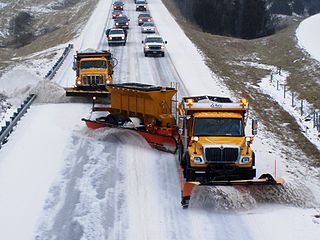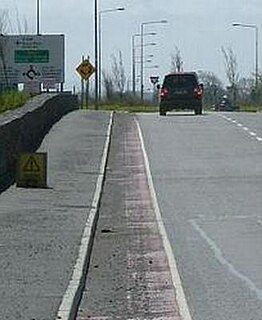
Loose chippings are loose gravel or stone fragments on a road surface and form a hazard to vehicles using that road. It may come from the road's chip seal. Causes include:

A road surface or pavement is the durable surface material laid down on an area intended to sustain vehicular or foot traffic, such as a road or walkway. In the past, gravel road surfaces, cobblestone and granite setts were extensively used, but these surfaces have mostly been replaced by asphalt or concrete laid on a compacted base course. Road surfaces are frequently marked to guide traffic. Today, permeable paving methods are beginning to be used for low-impact roadways and walkways. Pavements are crucial to countries such as US and Canada, which heavily depend on road transportation. Therefore, research projects such as Long-Term Pavement Performance are launched to optimize the life-cycle of different road surfaces.
A hazard is an agent which has the potential to cause harm to a vulnerable target. The terms "hazard" and "risk" are often used interchangeably. However, in terms of risk assessment, they are two very distinct terms. A hazard is any agent that can cause harm or damage to humans, property, or the environment. Risk is defined as the probability that exposure to a hazard will lead to a negative consequence, or more simply, a hazard poses no risk if there is no exposure to that hazard.

A vehicle is a machine that transports people or cargo. Vehicles include wagons, bicycles, motor vehicles, railed vehicles, watercraft, amphibious vehicles, aircraft and spacecraft.
- Unbound surplus aggregate not removed from the surface when the road is resurfaced.
- Raveling of a chip seal or asphalt concrete pavement. This is usually the result of a poor bond between the asphalt and the aggregate. As a result, the aggregate breaks free from the road surface.
- Raveling caused by mechanical wear from snowplows or studded snow tires.
- Gravel deposited on the road by erosion of cut sections above the road.
- Gravel carried onto the road by tyres of a vehicle that was driven onto a gravel shoulder, or entered a paved road from a gravel road.

Construction aggregate, or simply "aggregate", is a broad category of coarse to medium grained particulate material used in construction, including sand, gravel, crushed stone, slag, recycled concrete and geosynthetic aggregates. Aggregates are the most mined materials in the world. Aggregates are a component of composite materials such as concrete and asphalt concrete; the aggregate serves as reinforcement to add strength to the overall composite material. Due to the relatively high hydraulic conductivity value as compared to most soils, aggregates are widely used in drainage applications such as foundation and French drains, septic drain fields, retaining wall drains, and roadside edge drains. Aggregates are also used as base material under foundations, roads, and railroads. In other words, aggregates are used as a stable foundation or road/rail base with predictable, uniform properties, or as a low-cost extender that binds with more expensive cement or asphalt to form concrete.

Asphalt concrete is a composite material commonly used to surface roads, parking lots, airports, as well as the core of embankment dams. It consists of mineral aggregate bound together with asphalt, laid in layers, and compacted. The process was refined and enhanced by Belgian inventor and U.S. immigrant Edward de Smedt.

A snowplow is a device intended for mounting on a vehicle, used for removing snow and ice from outdoor surfaces, typically those serving transportation purposes. Although this term is often used to refer to vehicles mounting such devices, more accurately they are known as winter service vehicles, especially in areas that regularly receive large amounts of snow every year, or in specific environments such as airfields. In other cases, pickup trucks and front end loaders are outfitted with attachments to fulfill this purpose. Some regions that do not frequently see snow may use graders to remove compacted snow and ice off the streets. Snowplows can also be mounted on rail cars or locomotives to clear railway tracks.
Excessive speed while driving through loose chippings damage both the road and vehicles. Loose chippings can reduce traction and cause loss of control. This is a special hazard to motorcyclists and bicyclists, who may lose their balance and fall if their tires start sliding. Loose chippings can be picked up by tyres and damage them, or may be spun off to become high speed missiles, which may injure or damage other persons or vehicles on the road.

A tire or tyre is a ring-shaped component that surrounds a wheel's rim to transfer a vehicle's load from the axle through the wheel to the ground and to provide traction on the surface traveled over. Most tires, such as those for automobiles and bicycles, are pneumatically inflated structures, which also provide a flexible cushion that absorbs shock as the tire rolls over rough features on the surface. Tires provide a footprint that is designed to match the weight of the vehicle with the bearing strength of the surface that it rolls over by providing a bearing pressure that will not deform the surface excessively.
Loose chippings may accumulate on verges, where they may choke drainage channels. [1]
In many countries, road signs are put up, requiring vehicles to drive at a low speed. In the UK, these temporary traffic signs will require the driver to proceed at 20 mph.













